| |
|

D'HIER A AUJOURD'HUI
 The mountainous and impenetrable island of Dominica (pronounced ‘Domineeka’) was first seen by Columbus The mountainous and impenetrable island of Dominica (pronounced ‘Domineeka’) was first seen by Columbus
on a Sunday in November 1493, hence the name. He passed it by. In the 17th century the French coveted it because it lay neatly between Martinique and Guadeloupe, so they tried to get a foothold. For similar strategic reasons the English made several efforts to turf
them out. And just like everywhere else, the result was a century of struggle, although often the combatants joined together to defeat a common foe in the Caribs. For the latter, the island’s thick
jungle and craggy profile gave them an excellent redoubt from which they could launch harassing raids against the putative colonists. The Caribs’ instinct for autonomy was equalled only by their ferocity. So much so that in 1748 both the English and the French were discouraged enough to give up their first efforts at colonisation and wait for better times. The result was that Dominica was pronounced a neutral island belonging to the Caribs.
|
|
|
|
Fairly soon, however, the struggle began again, and thanks to better tactics the Caribs were pushed back from the coast to the island’s interior.
 Dominica became English in 1783, though the French hung on until 1805. A consequence of that long period of French influence can be seen in the numerous place names and a patois, spoken by almost everyone, very close to the creole of Martinique and Guadeloupe. Meanwhile the Caribs, who had been scattered all over the island, were brought together in a single reserve. There are still around 3000 surviving today. Dominica became English in 1783, though the French hung on until 1805. A consequence of that long period of French influence can be seen in the numerous place names and a patois, spoken by almost everyone, very close to the creole of Martinique and Guadeloupe. Meanwhile the Caribs, who had been scattered all over the island, were brought together in a single reserve. There are still around 3000 surviving today.
In 1967 the island became an associated state of the Commonwealth and gained full independence in 1978.
|
|
|








